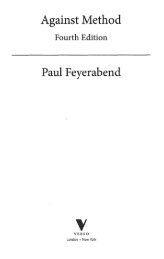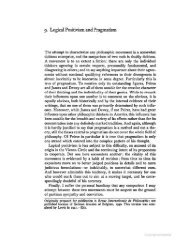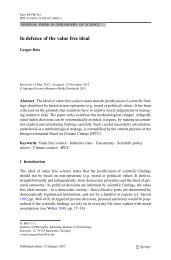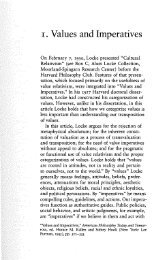Ethnographic Research - Matthew J. Brown
Ethnographic Research - Matthew J. Brown
Ethnographic Research - Matthew J. Brown
- No tags were found...
Create successful ePaper yourself
Turn your PDF publications into a flip-book with our unique Google optimized e-Paper software.
~ CHAPTER 13 ETHNOGRAPHIC RESEARCHenormous value since it keeps you close to your data. Youwill be making interpretations as you listen to the tapesmany times.Ethnographers' transcripts range from verbatimtexts of verbal and nonverbal interactions to summariesof what was said at what point, combined with your owntentative ideas, early bits of analysis, as well as notes onmethodological difficulties and your personal or emotionalexperiences from an interview or observationsession. You already know some elements to consider informatting transcripts and some of the conventions fornotating paraverbal interaction cues from the last chapter.Next, let's look at the steps you might take to makesense of your collected field notes.Coding and Reducing Field NotesFeldman (1995) described the problem of working throughmassive quantities of field data that included audiotapes,floppy disks, documents, field notes, and thousands ofpieces of electronic and hard mail. Feldman (1995) notedthat the complexity and ambiguity was at times overwhelming:"The task at hand is to create an interpretationof the setting or some feature of it that will allow peoplewho have not directly observed the phenomena to havea deeper understanding of them" (p. 2). Ethnographerscreate interpretations based on participants' meanings.To do so, you have to somehow get away from two kindsof prepackaged interpretation. First, you must avoid creatinginterpretations that are based only on what youknew about the setting before you began collecting data.Second, you must avoid creating interpretations that arebased only on what you know about other similar settings.In other words, your interpretations need to comefrom your field notes.Accordingly, then, as an ethnographer, you necessarilywill be involved in reducing and coding data asyou form interpretations and develop theoretic propositionsabout relationships between concepts in the settingyou study. You may impose coding categories onto yourdata from the outset, as is the case when ethnographersof speaking apply the SPEAKING framework. If you areplanning to "perform or adapt the data for the stage,you may also code with scenes for your performance inyour mind" (Madison, 2005, p. 37). Alternatively, youcould induce categories for coding data after considerableimmersion in the setting as is the case when youuse constant comparisons to develop a grounded theory(Glaser & Strauss, 1967) or when you use analytic induction(Goetz & LeCompte, 1984). For example, Lindsley(1999) used inductive reasoning to categorize differenttypes of misunderstandings and conflicts encountered byU.S. American and Mexican employees at a maquiladora(i.e., a u.S.-owned assembly plant located in Mexico).Based on data collected in interviews, nonparticipantobservations, and written periodicals on the maquiladoraindustry, Lindsley used constant comparison to groupproblematic interactions into three categories (e.g., negativelystereotyped identities).Another way that you can begin to analyze a cultureor group is to identify and describe the participants'rules for interaction. Rules are prescriptions for who canspeak, on what topics, in what settings, and how speakingby others is to be interpreted. One form that a communicationrule can take is "Do X in order to be seen as Y:'College students know many such rules, such as "Showup for class on time to be seen as a serious, motivatedstudent:' Rules are followable, prescribed, and contextual(Shimanoff, 1980, 1985). Therefore, rule-governedbehavior is controllable, criticizable, and contextual(Dollar & Beck, 1997). All of these characteristics suggeststrategies you can use to describe and evaluate the rulesfor conduct within a culture or group. For example, youcan look for breaches-instances when members violaterules and are called to account for their behavior; you cantry to analyze what rule has been violated in that case.Applying Descriptive FrameworksFrameworks are favored by some ethnographers whobelieve that it is impossible to enter a social scene completelyfree of any interpretive categories (Philipsen,1992). A variety of descriptive frameworks may be usedto analyze communication within a group or culture.As we mentioned earlier in this chapter, Hymes's (1962)SPEAKING framework is used by ethnographers of speakingto analyze a variety of cultural groups (e.g., Dollar,1999; Katriel & Philipsen, 1981; Philipsen, 1975, 1992;Ruud, 1995; Sequeira, 1993).One of the benefits of usingthe same descriptive framework across many groups isthe ability to compare interpretations across more thangroup or culture. If your interest is in comparing groupsor cultures, you will probably tend to see a description ofanyone social setting as a case study.Writing Case Studiesc. J. Mitchell (1983) and Philipsen (1982) have arguedthat theoretically plausible interpretations can be madefrom one good case (e.g., Bastien & Hostager, 1992;Braithwaite, 1997a; Eisenberg, Murphy & Andrews, 1998;






